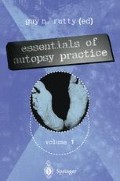Abstract
A bruise may be succinctly defined as a collection of blood, visible to the naked eye as an area of discolouration which has extravasated into surrounding tissues following vascular disruption, principally as a result of trauma or occasionally spontaneously, as a result of a disease process. Typically bruises are caused by blunt trauma, although they may be associated with any type of impact and accompanying all manner of wounds. Thus they can provide a wealth of information to assist the pathologist draw reasonable conclusions as to causation and assist with reconstruction of events leading to death.
Access this chapter
Tax calculation will be finalised at checkout
Purchases are for personal use only
Preview
Unable to display preview. Download preview PDF.
References
Prinsloo I, Gordon I. Post-mortem dissection artefacts of the neck and their differentiation from ante-mortem bruises. S Afr Med J 1951;25:358–61.
Vanezis P, Brierley C. Facial image comparison of crime suspects using video superimposition. Science and Justice 1996;36:27–34.
Greaves M. Haemorrhage, haemostasis and thrombosis. In: Mason JK, Purdue BN, editors. Pathology of trauma. 3rd ed. London: Arnold, 2000,440–60.
Langlois NEI, Gresham GA. The ageing of bruises: a review and study of the colour changes with time. Forensic Sci Int 1991;50:227–38.
Stephenson T, Bialas Y. Estimation of the age of bruising. Arch Dis Child 1996;74:53–5.
Moritz AR. The pathology of trauma. London: Henry Kimpton, 1942,21–34.
Spitz WU, Fisher RS. Medicolegal investigation of death. Springfield, IL: Charles C Thomas, 1974,124.
Virchow R. Die pathologischen pigmente. Virchows Arch Path Anat 1847; 1:379–486.
Fischer H, Reindel F. Über haematoidin. Hoppe-Seyler Z Physiol Chem 1923;127:299–316.
Langhans F. Beobachtungen über die resorption der extravasate und pigmentbildung in denselben. Virchow Arch Path Anat 1869;49:66.
Neumannn E. Beiträge zur kenntnis der pathologischen pigmente. Virchows Arch 1888;111:25.
Walcher K. Über vitale reaktionen. Dtsch Z Gerichtl Med 1930;15:16–57.
Berg S, Ebel R. Altersbestimmung subcutaner blutungen. Münch Med Wochenschr 1969;111:1185–90.
Betz P, Eisenmenger W. Morphometrical analysis of hemosiderin deposits in relation to wound age. Int J Legal Med 1996;108:262–4.
Nevelös AB, Gee DJ. Vital reaction in the epithelial connective tissue ground substance. Med Sci Law 1970;10:175–7.
Raekallio J. Histological estimation of the age of injuries. In: Perper JA and Wecht CH, editos. Microscopic diagnosis in forensic pathology, Ch. 1. Springfield, IL: Charles C Thomas, 1980, 3–16.
Mostafa K, Hamdy FE, Deatherage FE, Shinowara GY. Bruised tissue I. Biochemical changes resulting from blunt injury. Proc Soc Exp Biol Med 1957;95:255–8.
Laiho K. Biochemical and morphological changes in experimental subcutaneous hematomas. Proceedings of the 8th Meeting of the Scandinavian Forensic Society, Vedbaek, Denmark, 1982,141–146.
Vanezis P. Assessing hypostasis by colorimetry. Forensic Sci Int 1991;52:1–3.
Vanezis P, Trujillo O. Evaluation of hypostasis using a colorimeter measuring system and its application to assessment of the post-mortem interval (time of death). Forensic Sci Int 1996;78:19–28.
Trujillo O, Vanezis P, Cermignani M. Photometric assessment of skin colour and lightness using a tristimulus colorimeter: reliability of inter and intra-investigator observations in healthy adult volunteers. Forensic Sci Int 1996;81:1–10.
Vanezis P, Trujillo O, Grant P. Lecture to Police Surgeons Association (Autumn Symposium), 1997.
Brunsting LA, Sheard C. The colour of skin as analysed by spectrophotometric methods. J Clin Invest 1929;1:559.
Klein A, Rommeiss, Fischbacher C, Jagemann K-U, Danzer K. Estimating the age of hematomas in living subjects based on spectrometric measurements. In: Oehmichen M, Kirchner H, editors. The wound healing process: forensic aspects. Lubeck: Schmidt–Römhild, 1996,283–291.
Carson DO. The reflectance spectrophotometric analysis of the age of bruising and livor. MSc Thesis, University of Dundee, 1998.
Polson C.J. Injuries: general features. In: Polson CJ, Gee DJ, Knight B, editors. The essentials of forensic medicine, 4th ed., Ch. 3,1985,91–147.
Mueller B. Zur frage der unterscheidung von vitalen bzw. agonalen und postmortalen blutungen. Acta Med Leg Soc (Liege) 1964;17:43–46.
Laiho K. Immunohistochemical studies on fibrin in vital and postmortem subcutaneous haemorrhages. Ann Acad Sci Fenn [Med] 1967;128:1–85.
Pullar P. The histopathology of wounds. In: Mant AK, editor. Modern trends in forensic medicine, vol. 3. London: Butterworths, 1973.
Kibayashi K, Hamada K, Honjyo K, Tsunenari S. Differentiation between bruises and putrefactive discolorations of the skin by immunological analysis of glycophorin A. Forensic Sci Int 1993;61:111–7.
Camps FE. Gradwohl’s legal medicine 2nd ed. John Wright. 1976,265.
Glaister J. Medical jurisprudence and toxicology. Edinburgh: E&S Livingstone, 1973, 242–6.
Smith S, Fiddes FS. Forensic medicine. London: Churchill, 1955, 110–1.
Adelson L. The pathology of homicide. Springfield, IL: Charles C Thomas, 1974,382.
Editor information
Editors and Affiliations
Rights and permissions
Copyright information
© 2001 Springer-Verlag London Limited
About this chapter
Cite this chapter
Vanezis, P. (2001). Bruising: Concepts of Ageing and Interpretation. In: Rutty, G.N. (eds) Essentials of Autopsy Practice. Springer, London. https://doi.org/10.1007/978-1-4471-0699-9_11
Download citation
DOI: https://doi.org/10.1007/978-1-4471-0699-9_11
Publisher Name: Springer, London
Print ISBN: 978-1-4471-1181-8
Online ISBN: 978-1-4471-0699-9
eBook Packages: Springer Book Archive

